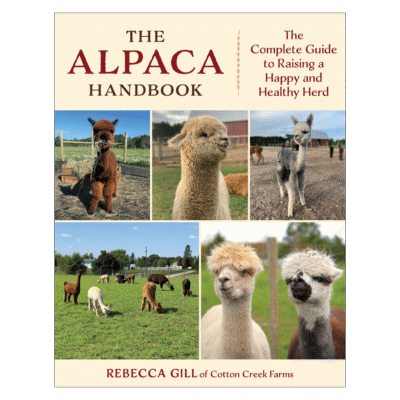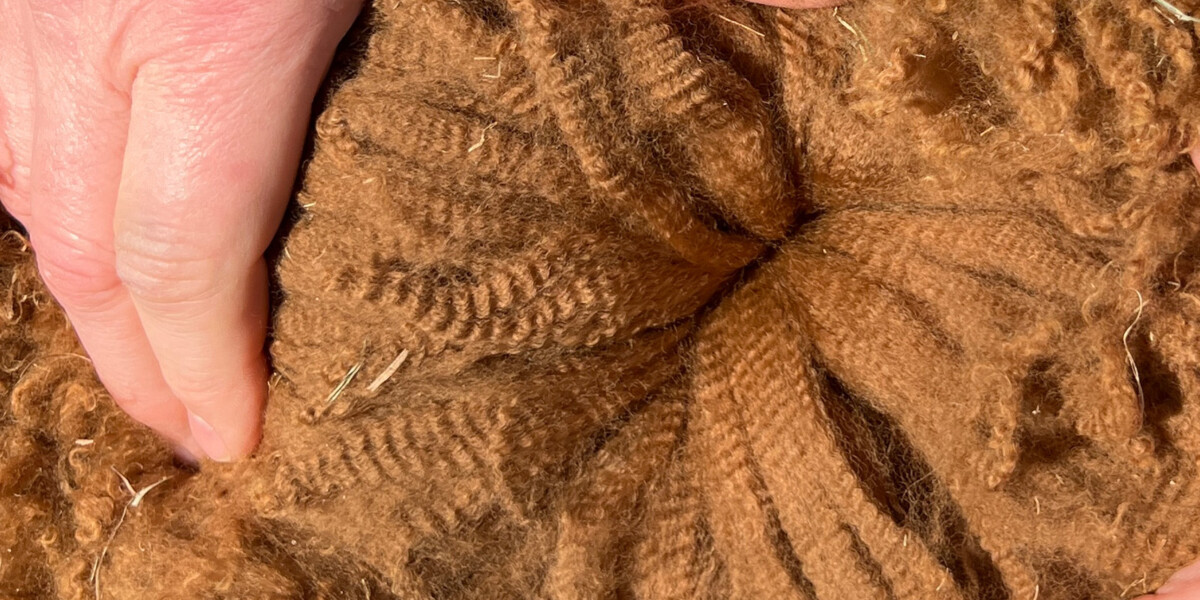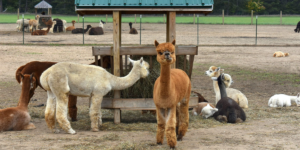This post was originally published in 2020 and updated in 2025.
When we first started visiting alpaca farms and shows, I kept hearing references to EPDs and histograms. I was pretty darn confused about these terms, because they were generally used individually and not in relationship to each other. I knew they were in reference to an alpaca’s fiber quality, but I didn’t understand the nuances of EPD vs. histogram results.
Let’s clear up the confusion quickly because once you compare the two directly, the discussion of fiber quality makes a whole lot more sense!
In the most basic sense, these two words are defined as:
- Histogram - Alpaca histograms are related to fiber quality at a given point in time. This helps an alpaca owner know what the fiber can be used for once harvested, it's a snapshot of the health of the alpaca, and the data helps alpaca owners make better breeding decisions.
- EPD - Alpaca EPD data is to the potential quality in an offspring’s fiber. This helps an alpaca breeder know the genetic worth of an alpaca, as well as, which alpacas should be bred and to whom they should be bred to.
In the most basic breakdown, a histogram is all about the here and now, while an EPD provides additional information about the potential of an alpaca's future offspring.
What is a Histogram?
A histogram is a measurement of quality for a specific alpaca’s fiber at the time of shearing or fiber sample. Many alpaca farms will take a sample of an alpacas fiber at shearing and send it out to a lab to obtain information on key data points like micron count or comfort factor. A histogram can also include metrics for crimp, strength, or density.
The fiber traits alpaca histograms evaluate include:
- Mean Fiber Diameter (MFD) – This fiber diameter is measured in microns and it is a very important measurement in the fiber industry. Lower micron counts represent a finer fleece and higher quality fiber. Fiber begins to have very limited usage once it surpasses 30 microns.
- Standard Deviation (SD) – This is the amount of variation occurring in a fiber sampling. The lower the number, the more uniform the fiber and the better the quality of fiber available for producing products. We like to see this number in the threes or low fours.
- Coefficient of Variation (CV) – This data point is the standard deviation as a percentage or average. A CV under 20 is very uniform, while a CV over 30 is not. We want to target the teens for this number.
- Fibers Greater Than 30 microns - The percentage of the fibers measured over 30 microns. Fiber over 30 microns does not produce soft enough yarn and would need to be used for another product such as dryer balls or felt.
- Spin Fineness - This provides an estimate of the performance of the fiber when it is spun into yarn. This information is intended for mills that process commercial runs of alpaca fiber.
- Comfort Factor – Like micron count, this helps alpaca farmers determine which fiber will make the most desirable yarn and products. The higher the comfort factor and closer to 100, the better the fiber.
- Mean Staple Length (mm) - Mean staple length is a measurement of the fiber length. This is a critical measurement, because short fiber (less than three inches for Huacaya alpacas) cannot be used for producing yarn and many other products via the worsted process.
- Length Standard Deviation (mm) - This is the standard deviation of staple length, and it is a measurement of the fiber’s consistency of length.
- Length Coefficient of Variation (%) - The length coefficient of variation is defined as the ratio of the standard deviation to the mean of fiber length.
- Mean Curvature (deg/mm) - Fiber curvature measures crimp or the number of waves (zigzags) per inch within the fiber. The greater the number of degrees per millimeter, the more waves you’ll see in the fiber. Finer crimp provides greater resistance to compression and better memory. This is important for the textile industry and producing end use products at scale.
- SD Curvature (deg/mm) - This is the standard deviation of curvature and is a measurement of the fiber’s consistency of curvature.
- Medullated Fibers – Medullation is a fiber trait that is evaluated in light colored alpacas (white or fawn) that helps quantify the hollow space within the fiber. Because this metric lends itself to describing coarse hair, it can be confused with the more common term guard hair. While there is a correlation between medullated fibers and coarseness, they are not the same.
Using Histogram Results
Below is Grace's histogram. She has a great results for both micron count and an amazing curvature. Her staple length is just about three inches and we would want to improve that with the next generation of Grace's offspring.
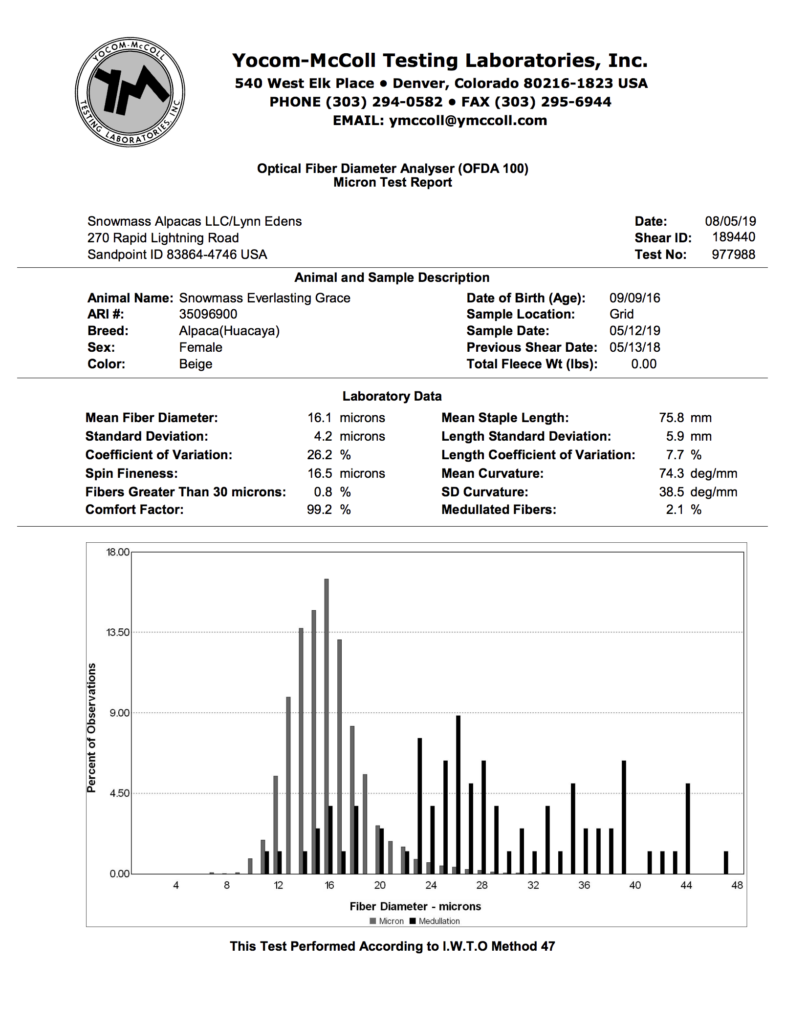
As an alpaca owner who uses fiber to produce things like socks, hats, yarn, felt, and dryer balls, I care about micron count and comfort factor because this highly influences what fiber can be used for, and thus, its overall worth. As a farmer, I want alpacas with the lowest micron count and the highest comfort factor possible. Since alpaca fiber degrades with age, starting with a low micron count will allow maximum usage of the fiber for the longest period of time.
However, this won’t do me any good if the staple length is so short that a mill cannot run it. So I also have to make sure we are purchasing and breeding alpacas with a decent staple length.
For breeding purposes, I care about all these above-mentioned traits, but additional factors become important like curvature and the coefficient of variation. I want to breed to correct issues, while not compromising existing strengths.
I also care about histogram results from year to year, because this helps me understand the health of my alpaca. While fiber quality starts with genetics, it is highly influenced by the environment. Aging, sickness, stress, and overeating will all increase micron count and degrade the quality of alpaca fiber.
And finally, if alpaca shows were my priority, curvation and crimp would be very important. A highly organized crimp is preferred, so an alpaca with a solid crimp structure will perform well in the show ring.
A Note on Prickle Factor: When evaluating histogram data we do look beyond just breeding information. We're also evaluating the quality of the fiber, the “prickle factor”, and our options for converting the fiber into yarn or other products. One of the advantages of alpaca fiber is the extreme softness of it and the fact that it is hypoallergenic. The prickle factor is the limit of irritability to the skin. So a higher prickle factor would start to negate the softness and hypoallergenic nature of the fiber. I am someone who has sensitive skin and I cannot wear anything made with sheep’s wool. The prickle factor would be incredibly important to me as a buyer of alpaca products because I have a low tolerance for anything that creates that prickly sensation. Sheep's wool breaks me out in a rash quickly, and for people like me, alpaca fiber with low microns and high comfort factor ratings is just what I need to be toasty warm and comfortable.
Factors That Impact Histogram Results
When Faith arrived at our farm, she didn’t have exceptional fiber. We adopted Faith because the 4-H called and asked if we could take her in. Her prior owners were aging and were not able to care for her as she required. They were right. Faith was okay, but was not in optimal physical or mental health. Honestly, she was afraid of her own shadow and it took me months to gain her trust and get her to sleep in the barn with the other alpacas.
After a few months, Faith learn to trust us, she'd sleep in the barn, and she'd even eat out of my hand. Once this happened you could truly see a difference in Faith’s fleece. She had a distinct line in her fiber which showed when she arrived at our farm and was able to settle into a more stress-free lifestyle. We provided better shelter, better nutrition, and lots of love. All of this was evident in the quality of her fiber and the yarn that it produces. Faith consistently generates lots of beautiful fiber that makes amazing yarn.

Stress is only one factor that can influence fiber quality. There are many other factors will degrade the quality of alpaca fiber and the resulting histogram results. Nutrition, soil, breeding history, and age are just a sampling of what can help or hurt your fiber harvest.
What is an EPD?
EPD stands for Expected Progeny Differences. The use of EPD data was introduced decades ago by Dr. Charles Henderson at Cornell University. Many livestock industries have adopted this data set and regularly use EPD data to make sound breeding decisions.
In the alpaca industry, EPDs are used to calculate nine fiber traits and one trait related to birth weight.
The current ten traits alpaca EPDs evaluate include:
- Average Fiber Diameter (AFD) – AFD is the average fiber diameter measured in microns. It is a very important measurement in the fiber industry. Lower micron counts represent a finer fleece and higher quality fiber. Fiber begins to have limited usage once it surpasses 30 microns, so alpaca owners must watch this metric closely.
- Standard Deviation of Fiber Diameter (SDAFD) - SDAFD represents the variation of fiber diameter. The smaller the standard deviation the more uniform the fiber. As alpaca breeders, our goal is to produce alpacas with very uniform fiber.
- Spin Fineness (SF) - This provides an estimate of the performance of the fiber when it is spun into yarn. This information is intended for mills that process commercial runs of alpaca fiber.
- Percentage of Fibers Greater than 30 Microns (%F>30) – This is another data point to help evaluate micron count and uniformity. Alpaca breeders seek alpacas with the least amount of fiber over 30 microns.
- Mean Curvature (MC) - Fiber curvature is related to crimp, with the greater the number of degrees per millimeter, the finer the crimp. Finer crimp provides greater resistance to compression and better memory.
- Standard Deviation of Mean Curvature (SDMC) - This metric illustrates the uniformity of curvature (crimp) within the fleece sample.
- Percent Medullated Fibers (%M) - Medullation, or the occurrence of a hollow core or hollow sections within the fleece, can be measured for white or very light colored fleeces. EPD values are only reported in the fiber analysis for white and light fleeces, as the measurement cannot be done on darker colored fleeces.
- Mean Staple Length (MSL) – This is the measurement of the fiber’s length in millimeters. A standard mill requires a minimum fiber length of three inches to process raw fiber into yarn. So at the very least, breeders seek alpacas that can produce over three inches of fiber length each year. However, in reality, we really desire more as it will ultimately yield more yarn and product.
- Fleece Weight (FW) – Fleece weight is exactly as it sounds. It is the weight of the fiber blanket when harvested. The greater the weight, the more yarn and product the individual alpaca can produce.
- Birth Weight (BW) – Just as it sounds, this is simply the recording of the alpaca’s weight at birth.
Each year the Alpaca Owner’s Association (AOA) collects fiber data from participating farms. This data is prepared by an independent third-party company using advanced equipment to evaluate fiber characteristics. While this data is generated on individual alpacas, it is also combined to provide metrics on the industry as a whole.
In the below video, Dr. Mark Enns of the Department of Animal Sciences at Colorado State University talks about the alpaca industries use of EPDs.
The more accurate data we have on EPDs, the better decisions we make as an industry and/or alpaca breeder. Stated another way, EPDs help the alpaca industry skip over the trial and error associated with random breeding decisions.
An alpaca lives for about 20 years and can only deliver one cria each year. That means every cria counts, and as an industry, we need to use EPD data to make sure these annual breedings are improving the genetics and output of the alpaca population.
EPDs help alpaca breeders match sires and dams based on an alpaca’s genotype (genetics). This helps us not make poor decision based solely on phenotype (appearance).
On our farm, I always place close attention on phenotype and personality, while my husband Jason studies the genotype. He focuses in on data, while I look for pleasing facial features, fiber visual and physical characteristics, and personality. At the end of the day, EPDs help my husband keep me from making poor emotional decisions.
An EPD Example
EPD data is provided along with an alpaca’s ranking within the country. Using Snowmass Everlasting Grace as an example again, we can see she had EPDs ratings in the top 1%, 5%, 10%, 15%, and 25% in the country. In fact, she was actually listed as the #1 alpaca (1 of 47,399) in the United States for mean curvature (MC) for 2018 and 2019. On paper, Grace's EPD ratings and ranks make her look pretty good.
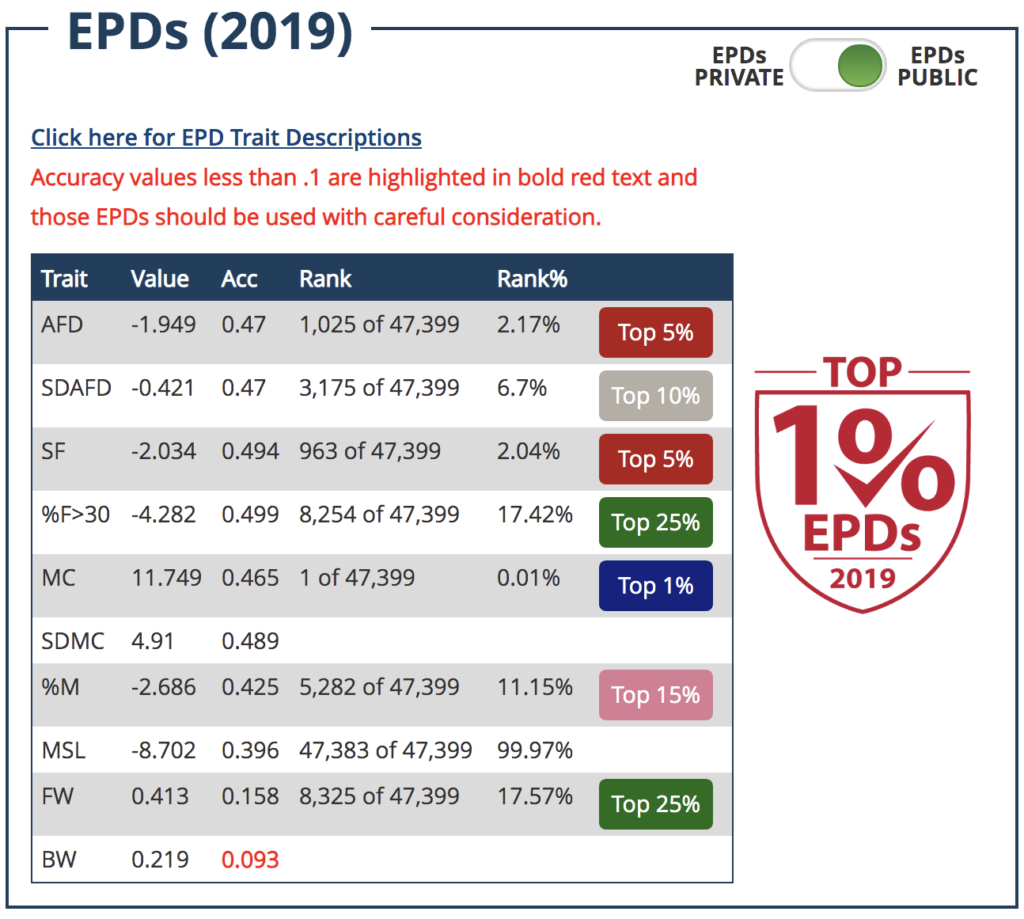
Grace’s sire is Snowmass Fortune Favors, who also ranks in the top 1% for Mean Curvature. He was actually 50 of 25,949 alpacas in 2019. He holds three other top 5% ranks and one 15% rank. On paper he looks pretty good. Grace’s dam is Snowmass Dreams Everlasting, who also ranked in the top 1% for mean curvature. She holds top 5%, 10%, 15%, and 25% rank just like her daughter. On paper she looks pretty good. So, Grace’s mother and father both had exceptional EPD ratings and they passed this onto Grace. Below is a screenshot of the Alpaca Owners Association's 2018 EPD Trail Leaders presentation that features Grace's rank as number one in the country for mean curvature.
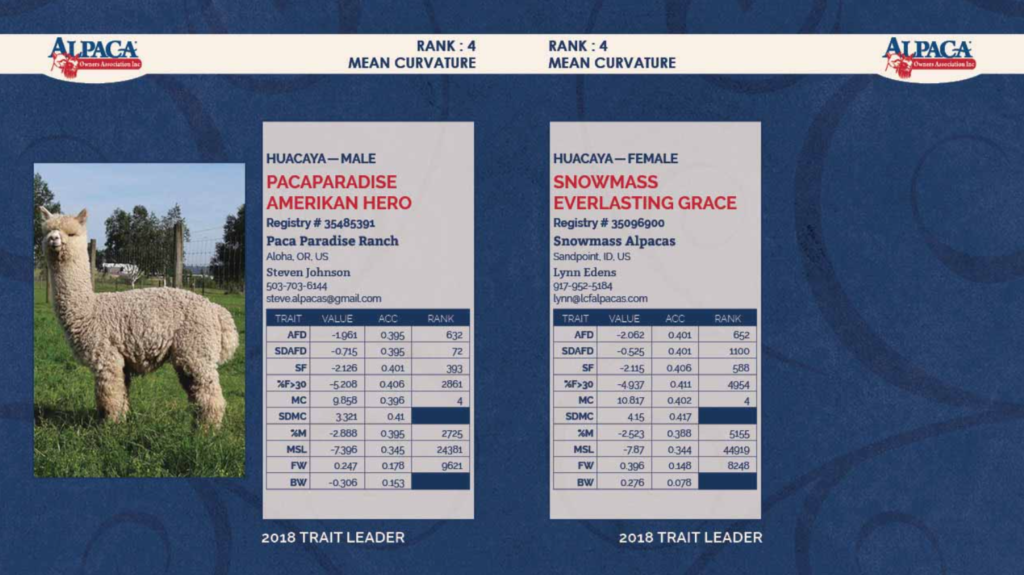
But as good as all that is, remember that EPDs are not the only thing we look at when selecting an alpaca. We also looked at her histogram data too. Snowmass provided photos of Grace’s fiber so we could see crimp and luster prior to purchase. And we studied Grace’s pedigree carefully. Grace’s lineage includes well-known dams and herdsires such as Snowmass Conopa XX, Snowmass Sub-Zero, and Snowmass Quechua. This was another indicator that Grace could produce quality offspring.
And as you see, throughout this discussion on EPDs, I keep referring to breeding and outcome of fiber characteristics for the cria. EPDs won't tell you about the current fiber quality, but they are a great tool for understanding breeding potentials.
The Takeaway on EPDs vs. Histograms
EPDs and histograms are two data sources that help alpaca owners purchase and breed alpacas for their maximum health and benefit to society. These two reporting options are used in conjunction with association registry information (lineage) and a visual review of the alpaca for conformation, fiber crimp and luster, and overall health.
A strong EPD cannot guarantee the production of an excellent offspring, nor can a histogram report provide all the details needed for fiber evaluation. EPDs and histograms are tools available to the alpaca industry that help alpaca breeders improve the genetics and health of their livestock.
The Alpaca Handbook: Everything You Need to Raise Healthy and Happy Alpacas
If you've enjoyed this content, you'll love Rebecca's new book. The Alpaca Handbook is the essential guide to raising, breeding, and enjoying alpacas on the farm. The book is a great resource for alpaca owners who raise them for fun or profit. In this 17 chapter, 200+ page, full color book, you’ll learn everything you need to know to become a successful alpaca owner. Each chapter includes educational information, as well as stories that tie this information to real-world experiences.
